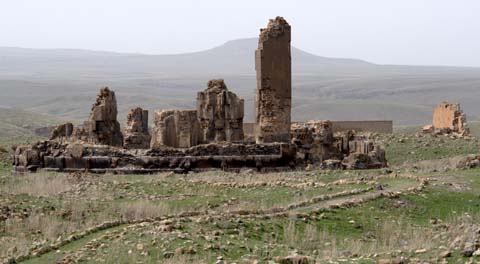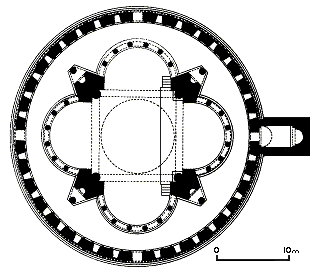New documentary about the Armenian Church of St. Gregory of Gagkashen in Ani –
New documentary about the Armenian Church of St. Gregory of Gagkashen in Ani –

It is thought that King Gagik (who reigned from the year 990 to 1020) chose the architect Trdat (the man who designed the cathedral of Ani) to build his “millennium” church, and it was probably erected between the years 1001 and 1005.
The structure was never very stable, and in 1013 strengthening had to be carried out – including the addition of a substantial amount of extra masonry around the middle two columns of each apse, converting them into piers. These consolidations were unsuccessful and the church collapsed shortly afterwards.
In the 13th century houses were built around the ruins, using some of the fallen church’s masonry. Later the ruined site became covered with earth, and at the end of the 19th century all that was visible were some walls on a tall mound.
The ruins were excavated in 1906 by Nikoli Marr. His excavations revealed the plan of the church and recovered many objects of worship, including a bronze candlestick and a chandelier.
History
It is thought that King Gagik (who reigned from the year 990 to 1020) chose the architect Trdat (the man who designed the cathedral of Ani) to build his “millennium” church, and it was probably erected between the years 1001 and 1005 (some books say between 990 and 1000).
The church at Vagharshapat referred to above was the grandiose cathedral of Zvart’nots (the “Vigilant Angels”) erected between the years 642 and 662, destroyed in the 10th century by an earthquake, and the most acclaimed architectural monument of early medieval Armenia. Zvart’nots was constructed at the supposed site of the meeting between King Trdat of Armenia and Saint Gregory the Illuminator as described by the Armenian historian Agathangelos in his account of the conversion of Armenia to Christianity during the 4th century. Tradition also says that it was built to house the remains of the saint.
The Architecture
The patron and possible designer of Zvart’nots was the Armenian Catholicos Nerses III (known as “The Builder”). He was pro-Byzantine, and his cathedral united Byzantine and Armenian architectural forms – resulting in an strikingly elegant, complex, and boldly innovative design.
Trdat’s design for Gagik’s church is of a circular ambulatory wrapped around an inscribed quatrefoil interior (four open apses contained within circular outer walls) that closely resembles the size and groundplan of the Zvart’nots original.
The structure was never very stable, and in 1013 strengthening had to be carried out – including the addition of a substantial amount of extra masonry around the middle two columns of each apse, converting them into piers. These consolidations were unsuccessful and the church collapsed shortly afterwards.
In the 13th century houses were built around and over the ruins, using some of the fallen church’s masonry. Later the ruin site became covered with earth, and at the end of the 19th century all that was visible were some walls on a tall mound. By this time, knowledge of the location of Gagik’s church had become lost and the site was said to cover the remains of the “synod house” for the Armenian Church in Ani.
The ruins were excavated in 1906 by Nikoli Marr. His excavations revealed the plan of the church and recovered many objects of worship, including a bronze candlestick and a chandelier. A detailed account of the excavation of this church is contained in Marr’s 1934 book “Ani, a history of the city and its excavations”. You can read a translation into English of the chapter dealing with the 1905 excavations here.


